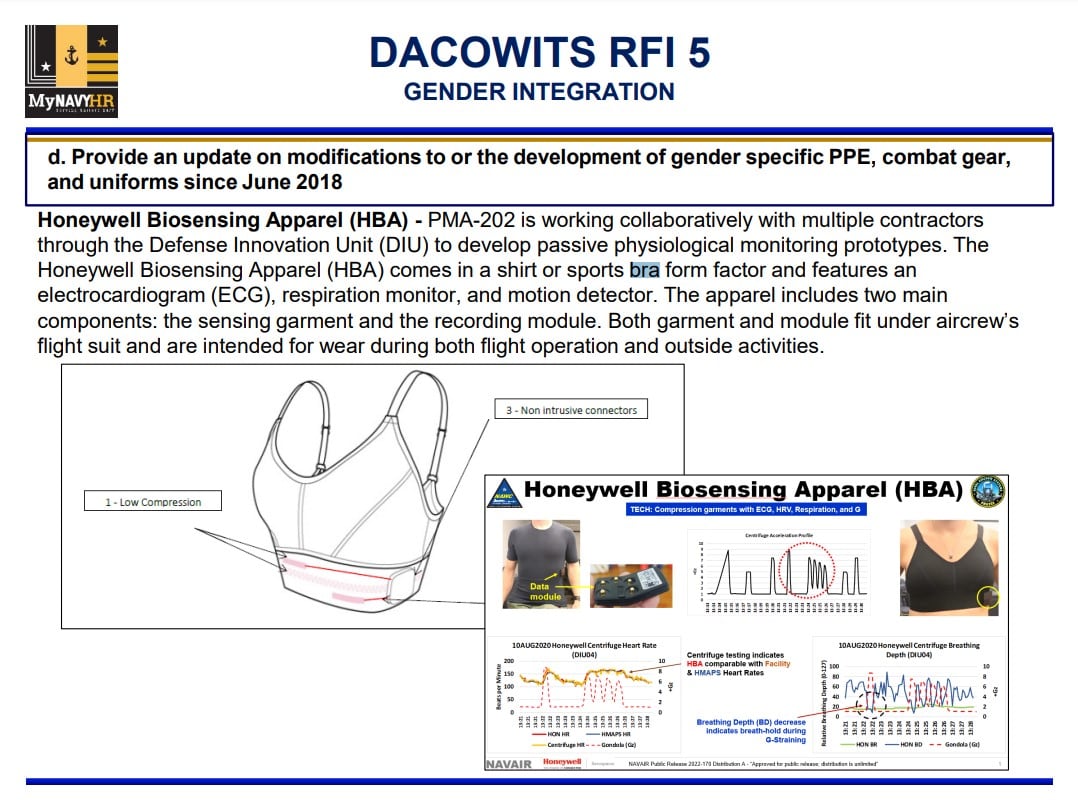[Editor’s note: This story has been updated to include additional information from the Navy, provided after its original publication.]
The next high-speed accessory for naval aviators is being designed with women in mind.
In 2023, the Navy plans to make a design decision on a biosensing bra and undershirt intended to monitor the vital signs of aircrew while in flight. These compressive garments, designed in partnership with the Defense Innovation Unit, feature built-in sensors that can measure breathing, heart rate and acceleration. These garments may offer a new way to detect early signs of trouble in the cockpit before they turn into a “physiological episode,” or medical emergency. Just as notably, the development process marks an effort to tailor designs to female pilots in a service that has often treated their needs as an afterthought.
Dr. Bethany Shivers, a branch head at the Naval Air Warfare Center Aircraft Division, presented the service’s plans to field smart undergarments at the December quarterly meeting of the Defense Advisory Committee on Women in the Services, or DACOWITS. According to a schematic she shared with the committee, the sports bra design will include a data recorder in the band — the location where a chest-strap heart rate sensor is worn. Special biosensing material, made by Honeywell, performs the function of an electrocardiogram, respiration monitor and motion detector.

This remarkable fabric with built-in sensors can also detect, officials said, how successfully the wearer is performing anti-G straining maneuvers, or AGSMs — a physical exercise not unlike giving birth that is essential to improving tolerance of G-forces and preventing G-LOC, or loss of consciousness due to pulling G’s.
“The apparel includes two main components: the sensing garment and the recording module,” Shivers’ presentation stated. “Both garment and module fit under aircrew’s flight suit and are intended for wear during both flight operation and outside activities.”
Amie Blade, a spokeswoman for Naval Air Systems Command, told Military Times that the Naval Aircrew Systems program office had been developing the bra with DIU since 2018, but expected to make a decision this fiscal year about which sensors will ultimately be included in a biosensing apparel program of record. She said the Navy is considering multiple companies and in the early stages of researching biosensing garment solutions and design.
Honeywell was selected in 2021 to develop a possible design. The downselect process began in 2018 with 52 companies, and the pool was narrowed to six in 2019, Blade said. The work to develop prototypes of what the service is calling Honeywell Biosensing Apparel, or HBA, is being funded through an Other Transactional Agreement, or OTA, executed by the Defense Department.
So far, Blade said, versions of the bra and undershirt have been tested on humans in “altitude chambers, centrifuges and test aircraft” to simulate in-flight conditions and environmental stressors.
The Navy envisions these garments ultimately becoming part of a “multi-sensor suite” that can collect numerous physiological readings on aircrew and head off developing problems or address concerning trends.
The Navy and the Air Force both saw major physiological episode spikes in the cockpits of certain fighter aircraft around 2017. To address these largely unexplained phenomena, which typically presented as shortness of breath and heart rate spikes, the Navy created a “Physiological Episodes Action Team” headed by a one-star admiral. Ultimately, the team found there were no problems with the jets themselves, but did recommend increased data collection to pinpoint future problems. Darpa’s “Project ICEMAN” is among a handful of other military efforts now in process to outfit jet cockpits with high-tech sensors.
For the Navy, which features a female aviator population of about 12% and a percentage of female fighter pilots in the single digits, flight garments and accessories tailored to women’s needs have often been lacking. The service is still determining the way ahead for an “in-flight bladder relief system,” according to the DACOWITS presentation, that will allow female pilots to urinate comfortably in the cockpit. NAVAIR revealed a first maternity flight suit prototype just last year.
Blade indicated the decision to invest in a bra for female aircrew was both practical and a deliberate effort to better serve women in the naval aviation community.
“Female-specific garments were developed to ensure optimized performance,” she said. “To guarantee accuracy of the system, the sensors are designed to be conformal with the skin and to best fit the anatomical features of both female and male Sailors and Marines. In the case of under-garments, it is important to offer tailored options for both women and men to ensure comfort and support personal preference.”
Design of female-specific flight gear, she added, “closely aligns with the Navy’s policy on Inclusion and Diversity and priority to ensure the readiness of all warfighters.”



